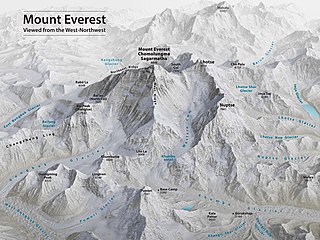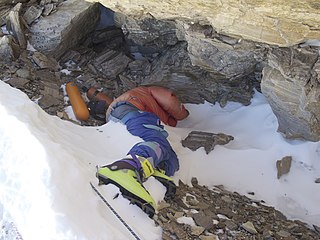
Mount Everest is Earth's highest mountain above sea level, located in the Mahalangur Himal sub-range of the Himalayas. The China–Nepal border runs across its summit point. Its elevation of 8,848.86 m (29,031.7 ft) was most recently established in 2020 by the Chinese and Nepali authorities.

Lhotse is the fourth highest mountain in the world at 8,516 metres (27,940 ft), after Mount Everest, K2, and Kangchenjunga. Part of the Everest massif, Lhotse is connected to Everest via the South Col. Lhotse means "South Peak" in Tibetan. In addition to the main summit at 8,516 metres (27,940 ft) above sea level, the mountain comprises the smaller peaks Lhotse Middle (East) at 8,414 m (27,605 ft), and Lhotse Shar at 8,383 m (27,503 ft). The summit is on the border between Tibet and the Khumbu region of Nepal.

Raymond Lambert was a Swiss mountaineer who together with Sherpa Tenzing Norgay reached an altitude of 8611 metres of Mount Everest, as part of a Swiss Expedition in May 1952. At the time it was the highest point that a climber had ever reached. There was a second Swiss expedition in autumn 1952, but a party including Lambert and Tenzing was forced to turn back at a slightly lower point. The following year Tenzing returned with Edmund Hillary to reach the summit on 29 May 1953.

Dhaulagiri is the seventh highest mountain in the world at 8,167 metres (26,795 ft) above sea level, and the highest mountain within the borders of a single country (Nepal). It was first climbed on 13 May 1960 by a Swiss/Austrian/Nepali expedition. Annapurna I is 34 km (21 mi) east of Dhaulagiri. The Kali Gandaki River flows between the two in the Kaligandaki Gorge, said to be the world's deepest. The town of Pokhara is south of the Annapurnas, an important regional center and the gateway for climbers and trekkers visiting both ranges as well as a tourist destination in its own right.

Scott Eugene Fischer was an American mountaineer and mountain guide. He was renowned for his ascents of the world's highest mountains made without the use of supplemental oxygen. Fischer and Wally Berg were the first Americans to summit Lhotse, the world's fourth highest peak. Fischer, Charley Mace, and Ed Viesturs summitted K2 without supplemental oxygen. Fischer first climbed Mount Everest in 1994 and later died during the 1996 blizzard on Everest while descending from the peak.

Robert Edwin Hall was a New Zealand mountaineer. He was the head guide of a 1996 Mount Everest expedition during which he, a fellow guide, and two clients died. A best-selling account of the expedition was given in Jon Krakauer's Into Thin Air, and the expedition has been dramatised in the 2015 film Everest. At the time of his death, Hall had just completed his fifth ascent to the summit of Everest, more at that time than any other non-Sherpa mountaineer.
Romeo Roberto "Romi" Garduce, sometimes nicknamed as "Garduch," is a Filipino mountain climber, a scuba dive master, an environmentalist, writer, motivational speaker and works as an IT professional. He began climbing mountains for a cause in 1991 as a member of the UP Mountaineers. Aside from being a mountain climber and IT professional, he became one of the host for the GMA Network public affair shows Born to Be Wild and Pinoy Meets World. He also hosted the GMA News and Public Affairs special entitled Pito Para sa Pilipino with Richard Gutierrez.
Leo Oración is a Filipino mountaineer and sportsman widely recognized as the first Filipino to reach the summit of Mount Everest on May 17, 2006, at the age of 32. He reached the summit at 3:30 p.m., together with 15 other climbers.

Mount Everest is the world's highest mountain, with a peak at 8,849 metres (29,031.7 ft) above sea level. It is situated in the Himalayan range of Solukhumbu district, Nepal.

Dale Sto. Tomas Abenojar is a Filipino mountaineer and an adventure sportsman and a mountain guide by profession. He is the founder of an evangelical Christian ministry called Gospel Expedition Ministries. He graduated from Living Waters' U.S.A. School of Biblical Evangelism in 1995 and is now a practicing missionary evangelist. In 2006, he was recognized as "the first Filipino" to reach the summit of Mount Everest by veteran Himalayan expedition chronicler Elizabeth Hawley. According to Hawley Dale reached the summit on May 15, 2006. Abenojar was certified by the China Tibet Mountaineering Association (CTMA) on May 20, 2006 to have summitted Everest via the North Col on May 15, 2006 at 10:45 a.m. Beijing time.
Lincoln Ross Hall OAM was a veteran Australian mountain climber, adventurer, author and philanthropist. Lincoln was part of the first Australian expedition to climb Mount Everest in 1984, which successfully forged a new route. He reached the summit of the mountain on his second attempt in 2006, miraculously surviving the night at 8,700 m (28,543 ft) on descent, after his family was told he had died.

David Sharp was an English mountaineer who died near the summit of Mount Everest. His death caused controversy and debate because he was passed by a number of other climbers heading to and returning from the summit as he was dying, although a number of others tried to help him.
Nawang Gombu was a Sherpa mountaineer who was the first man in the world to have climbed Mount Everest twice.
Lopsang Jangbu Sherpa was a Nepalese Sherpa mountaineering guide, climber and porter, best known for his work as the climbing Sirdar for Scott Fischer's Mountain Madness expedition to Everest in Spring 1996, when a freak storm led to the deaths of eight climbers from several expeditions, considered one of the worst disasters in the history of Everest mountaineering. Notwithstanding controversy over his actions during that expedition, Lopsang was well-regarded in the mountaineering community, having summited Everest four times. Lopsang was killed in an avalanche in September 1996, while again on an expedition to climb Everest for what would have been a fifth ascent.

Garrett Madison is an American mountaineer, guide and expedition leader. Madison began guiding professionally in 1999 on Mount Rainier and has reached the top of Everest 11 times. His company, Madison Mountaineering, specializes in climbs on Mount Everest and other high altitude peaks, operates on the highest peaks on all seven continents, and also provides training programs and summit climbs in Washington State.

The May 1996 expedition by the Indo-Tibetan Border Police to reach the summit of Mount Everest happened in the background of the 1996 Mount Everest disaster, and resulted in three members of the expedition dying.

Nirmal Purja is a Nepal-born naturalised British mountaineer and a holder of multiple mountaineering world records. Prior to taking on a career in mountaineering, he served in the British Army with the Brigade of Gurkhas followed by the Special Boat Service (SBS), the special forces unit of the Royal Navy. Purja is notable for having climbed all 14 eight-thousanders in a record time of six months and six days with the aid of bottled oxygen. He was also the first to reach the summits of Mount Everest, Lhotse and Makalu in a time period of 48 hours. In 2021, Purja, along with a team of nine other Nepalese mountaineers, completed the first-ever winter ascent of K2.
Carina Dayondon is a Filipina mountaineer, adventurer, and Philippine Coast Guard officer who was the first Filipina to reach the Seven Summits, the seven tallest mountains in every continent in the world, and the second Filipina to reach the summit of Mount Everest.
Noelle Christina Wenceslao is a Filipina mountaineer, adventurer, and Philippine Coast Guard officer who, on 16 May 2007, became the first Filipina to reach the summit of Mount Everest. She, along with fellow female mountaineers Carina Dayondon and Janet Belarmino, reached the summit of Mount Everest as part of an all-women Philippine expedition that climbed the tallest mountain in the world from the northern route and descended via the southern route.















